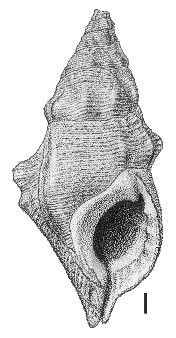
Revised descriptions of New Zealand Cenozoic Mollusca from Beu and Maxwell (1990)

 | Revised descriptions of New Zealand Cenozoic Mollusca from Beu and Maxwell (1990) | 
|
  (Pl. 24l): Clifden, J.A. Thomson Collection (almost certainly from Long Beach Shellbed), Altonian (M21617, National Museum of NZ) |
Beu & Maxwell (1990): Chapter 11; p. 223; pl. 24 l.
Synonymy: Austrotriton neozelanica Marshall and Murdoch 1923a, p. 123; Charonia neozelanica; Proxicharonia neozelanica; Charonia clifdenensis Finlay, 1924b, p. 460; Proxicharonia clifdenensis
Classification: Ranellidae: Cymatiinae
Description: Moderately large for subgenus (height 45-78 mm), elongate-fusiform, spire conic, almost straight-sided, about half total height. Protoconch dome-shaped to low turbiniform, of about 2.5 smooth whorls. Teleoconch with very low, wide varices at each 0.67 whorl, merging into whorl surface behind but moderately elevated above surface in front, each intervariceal interval expanded and coarsely nodulose immediately after each Varix but low and weakly sculptured before succeeding varix, producing a flattened area behind aperture at each growth stage and an irregularly coiled, alternately expanded and contracted shell resembling the much larger Charonia. Sculpture of a peripheral row of prominent, rounded nodules, from 3 very large ones to 7 relatively small ones in each intervariceal interval; whole surface crossed by low, narrow, widely spaced, weakly gemmate spiral lirae and faint growth ridges. Aperture oval to subcircular; inner lip callus thick, smooth except for a large parietal ridge and 3-8 low, indistinct ridges at base of columella. Outer lip lightly flared over terminal varix, with 7-8 low nodules within.
Comparison: The accumulation by GNS of reasonably large suites of specimens of the Sassia neozelanica-S. palmeri group (particularly from Long Beach Shellbed, Clifden, also other horizons at Clifden; four from Target Gully Shellbed and Awamoa Creek; three small specimens from Clifdenian-Tongaporutuan of eastern North Island; the National Museum Opoitian specimen from Oweka Creek reported by Beu (1976a, p. 305, fig. 10)); and the acquisition of a large number of Recent specimens by Museum of N.Z. Te Papa Tongarewa from Northland, the Kermadec Ridge and the Norfolk Ridge (Beu 1978b, p . 32) has demonstrated that apart from S. arthritica and the undescribed species mentioned below, two members of this species group seem to be recognisable in New Zealand: S. neozelanica (Altonian-Lillburnian ?) and S. palmeri (Tongaporutuan-Recent). The Long Beach sample (14 specimens, probably also the figured specimen) is very variable in coiling regularity, in number and size of peripheral nodules, and in coarseness of spiral lirae, and some modern shells and Awamoa Creek shells are closely comparable in these respects. However, most Tongaporutuan to Recent specimens have more prominent varices than older specimens, and S. palmeri is probably a separate species. A few specimens from Awamoa Creek and Clifden and some modern juvenile specimens retain the protoconch, which is almost exactly like that of S. maoria, but slightly shorter. There are no significant teleoconch characters distinguishing S. neozelanica from other species of Sassia, and as the radula is also very similar to that of S. parkinsonia (Cernohorsky 1970b), S. neozelanica is regarded as a member of a local species group of Sassia with unusually elongate shells. An unnamed small, coarsely gemmate species of this group is known from a few poor specimens from McCulloch's Bridge, South Canterbury (Kaiatan). The only other known members of the group are an unnamed species from Parengarenga Harbour (Altonian), and S. arthritica (type species of Proxicharonia Powell, 1938) which is known by two specimens from Waiheke Island, Auckland (Otaian) and one from Trig Z, Otiake (Waitakian). These differ from S. neozelanica mainly by their much finer spiral threads, and are possibly not distinct.
Distribution: Altonian-Lillburnian; Target Gully Shellbed, Oamaru, Altonian (type locality of A. neozelanica); Awamoa Creek; Calamity Point Sandstone, Clifden, Altonian (type locality of C. clifdenensis) and other Altonian-Lillburnian horizons at Clifden
Cite this publication as: "A.G. Beu and J.I. Raine (2009). Revised
descriptions of New Zealand Cenozoic Mollusca from Beu and Maxwell (1990). GNS
Science miscellaneous series no. 27."
© GNS Science, 2009
ISBN
978-0-478-19705-1
ISSN 1177-2441
(Included with a PDF facsimile file
copy of New Zealand Geological Survey Paleontological Bulletin 58 in CD version
from: Publications Officer, GNS Science, P.O. Box 30368 Lower Hutt, New
Zealand)